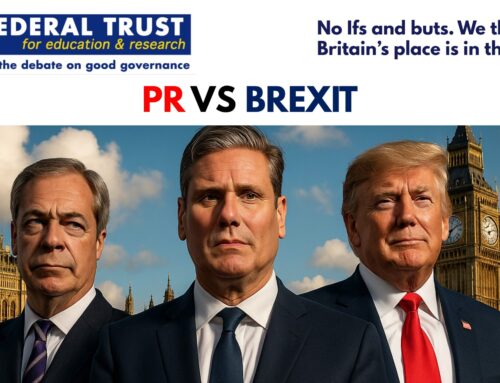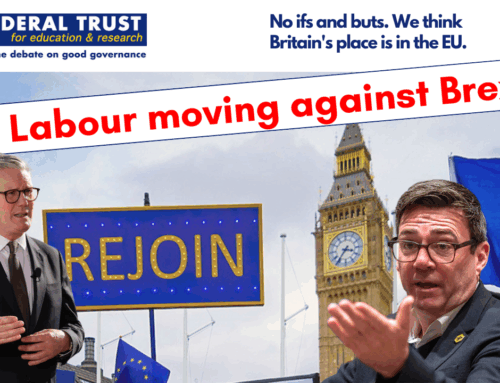
by Dr Kirsty Hughes
Director, Scottish Centre on European Relations
13th October 2019
This article was first published by Scottish Centre on European Relations
With the end of October approaching, an intense, highly political two weeks is set to play out. Brexit’s constant companion, uncertainty, remains as present as ever.
Questions abound. Might Johnson’s pivot on Northern Ireland result in a deal and could it then get through the Commons – and when? Might cross-party cooperation finally lead to Johnson’s ousting – or will it focus, with the courts, on ensuring there is indeed an extension to Article 50 (if the EU agrees)? Might the Commons finally back a people’s vote or will there be an election, before or after Brexit happens (if it does)?
There has been much speculation on the nature of the apparent breakthrough after Johnson and Varadkar’s talks last Thursday. But, in essence, it appears to be – as it would have to be to engage the EU – focused on shifting any customs border to the Irish Sea and away from the Irish border. Johnson has also called a Saturday sitting of the Commons on the 19th – presumably, in some form, to try to get round the Benn Act requirement to ask for an extension of Article 50 if a deal has not been passed by then.
It’s hard to see how there could be a clear, legally watertight text before Saturday nor that MPs would vote for it with little time to read it let alone have real scrutiny. And if, even so, Johnson could somehow bring together Tory, DUP and the Kinnock group of MPs to create a majority vote for it, then there would still need to be a withdrawal agreement implementation bill passed. So there is still time and routes – also with the vote on the Queen’s speech – that could allow for votes of no confidence or on a temporary government of national unity, or a vote for a people’s vote.
This is a crunch moment: if there is a majority for a putative Johnson deal, then there probably isn’t a majority for a people’s vote or a no confidence vote, and vice versa. If, as some are claiming, there is now belatedly a Commons majority for another EU referendum, which could be a major game-changer, that still leaves the key question of who would be prime minister while such a referendum was held.
It’s hard to imagine Johnson agreeing to hold such a vote while prime minister. So a majority for a referendum would have to hang together to then back a temporary government (where so far no majority has come together) or to go into an election with a vote of no confidence (after which there may or not be a majority for a second EU referendum any more anyway).
Three main scenarios
Amidst these various, politically contentious questions and multiple scenarios, there are perhaps three main ones:
(1) Brexit with a deal: Johnson agrees a deal with the EU which passes in the Commons and, with a small delay, the UK leaves the EU on a hard Brexit ticket;
(2) Article 50 extension and election: there is no deal or it doesn’t pass in the Commons, leading (despite Johnson’s resistance) to an Article 50 extension request, most likely to hold an election – in this case the EU and UK’s agreement to extend would be probably followed by a no confidence vote to trigger an early election; or
(3) Article 50 extension and a people’s vote: Johnson’s deal is either passed subject to a people’s vote or a separate motion or bill is passed agreeing a people’s vote. This would need a temporary unity government to hold it and EU agreement on an Article 50 extension.
There are of course various permutations on these three – and how long an extension the EU offers (two weeks, three months, end of June 2020) may impact considerably on the UK’s domestic politics at this crucial moment. No deal has, in legal terms, been ruled out by the Benn Act. Whether Johnson may yet try to find some way round this if he doesn’t get a deal or his deal is rejected is an open question but the momentum appears to be moving away from this most damaging option. If, at the last minute, it re-appeared, the Commons could then end up choosing between no deal and revoke – to wider political pandemonium across the UK.
Which Brexit?
If Brexit does happen in the short term, it will be accompanied by Johnson’s longer term goals in a revised political declaration. Johnson is aiming at a harder Brexit than May did since he insists the UK (presumably effectively only Britain) comes out of the EU customs union. Given he’s also apparently unwilling to sign up to the level playing field commitments that May made, the UK in this type of Brexit would be heading for a very hard Brexit, barely better than trading on WTO terms, with a basic free trade deal. This would be damaging for trade in goods – and, whether a May or Johnson deal, Brexit will also be bad for services (including for Northern Ireland since any backstop applies only to goods).
But if we are also, as seems likely/inevitable, heading for an election, it’s possible we could see a minority Labour government. Corbyn has said he would agree a customs union and single market alignment deal then put it to a referendum. This could mean either a softer Brexit or, if a referendum voted for remain, no Brexit.
This could unwind in different ways too. Perhaps Johnson would win a small majority in an election which could disappear within a year or two – so a Labour government could take over while talks were still going on over the future relationship and quite likely while the UK was still in transition, and shift the focus back again to a customs union. Clarity and an end to uncertainty do not appear likely in any scenario. A referendum and a remain vote would perhaps give the most clarity – and certainly the last economic damage. But the major divisions across the UK, notably in England, the rightward populist shift of the Tory party, the splits in the Labour party and more, make it hard to see a rapid recovery from these damaging Brexit years even in a remain scenario. In all scenarios, bitter divisions in England look to be the likely legacy. And if Brexit goes ahead while Scotland is denied a second independence referendum, tensions will rise too.
Which referendum?
For there to be a chance of the UK staying in the EU, other than the Commons voting to revoke Article 50, there are two main routes to a referendum – both presume Brexit has not yet happened. One is a Corbyn government after an election. And one is a temporary unity government that would stay in power long enough to hold a referendum and then, after such a vote, presumably hold an election.
The SNP has backed holding a second EU referendum since October 2018. But while it seems clear the SNP would back a temporary government for a few weeks to get an Article 50 extension then an election, it is much less clear if the SNP would back a 6 month temporary government to hold a referendum – nor is it clear what sort of outcry there might be from leave voters about such a temporary government. And Nicola Sturgeon has made it clear she would not support in any way a minority Labour government following an election without a commitment to a section 30 order and a second independence referendum.
But the LibDems, and those Tory MPs that might or do back, a second EU referendum are unlikely to play ball on a second independence referendum, so the route ahead to a people’s vote on Brexit, rather than just to an election looks potentially fraught – depending on the numbers in a new House of Commons.
The Brexit endgame is entering a crucial two weeks. There are as many moving parts and as much uncertainty as ever. One crucial element of the days ahead will be whether the cross-party opposition at Westminster finally and belatedly manage to agree on what they are for – and to get a majority for that – and not just what they are against. We will soon see the answer.




